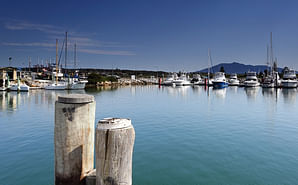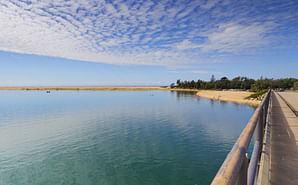History of the Shire
Some history about the Bega Valley Shire.
Our Traditional Owners
The Traditional owners of the Shire are the communities of the Yuin-Monaro Nations. From ancient times they have been the inhabitants and custodians of the land, sea and waterways. The cultural geography of the south coast is in the following terms, reverting to the coastal clans are the Murring, or especially the Yuin clans. These claimed responsibility of country from Cape Howe to the Shoalhaven River in NSW. They formed two large sub-groups or sub divisions, called respectively Guyangal and Kurial, from the words guya, south and kuru, north, gal being the possessive postfix. The inland extent of their country included the fall from the coast range to the sea.
Evidence is limited but the tabulation of marriages makes it quite clear that the far south coast formed a distinct region marked by the intensity of intermarriage while demonstrated that there were, nevertheless, links with Gippsland and the Monaroo prior to colonisation as would be expected, since few if any groups lived completely isolated from their neighbours.
The Tadjera-Munji-Djiringanj (from Cape Dromedary south to beyond Bega, inland to the sharp scarp of the Dividing Range east of Nimmitabel), Thaua (north of Merimbula south to Green Cape and west to the scarp of the Dividing Range), Bidawahal (just south of Green Cape) and Nulliker (Twofold Bay), Monaroo (on the escarpment country) groups comprised the Yuin-Monaro Nations in the area now known as the Bega Valley Shire. This was the case for many thousands of years.
The groups of the Yuin communities living in coastal areas are known as (Katungal from the work Katung) sea coast people and the Baianbal or Paienbara (the tomahawk people) those who lived in the forests. A third group, the Bemerigal or mountain people at Cooma belonged to the Ngarigo people.
Sites throughout the Shire demonstrate occupation by these rich cultures to be in excess of 7,000+ years. These people nurtured an organised and active culture many thousands of years older than the creators of the great pyramids of Giza did or the medieval monuments of Stonehenge did. Some of the oldest physical records of human occupation and activity to be found anywhere in the world are located beneath our noses here in the Bega Valley Shire.
Shipwrecked Crews and Aboriginal Contact in NSW
Numerous meetings occurred between European shipwreck crews and the Aboriginal populations during the eighteenth and nineteenth century in New South Wales. With the developing pattern of sea-borne trade, other ship's crews interacted with Aboriginal people as a result of tragic shipwreck.
One of the earliest recorded contacts with Aboriginals outside of Sydney occurred on the southern coast of New South Wales as a result of a shipwreck in Bass Strait. When the trade Sydney Cove wrecked on Preservation Island in the Flinders Group during 1797, a party of seventeen of the crew sailed across to the Victorian coast in an open boat and walked to Sydney. After two and a half months, only three survived the arduous trek, being found at Wattamola near Botany Bay.
They traversed the entire southern coastline from Cape Howe. A published account of their epic walk reveals a mixture of genuine compassion from the various Aboriginal (Yuin) groups that they encountered, to all out conflict as a result of territorial and resource infringements.
Extracts from the Journal: Narrative of the Shipwreck of Captain Hamilton and the crew of The Sydney Cove
15 March 1797: We began our journey for Port Jackson
18 March: Forded several branches of rivers. We this day fell in with a party of natives, about fourteen, all of them entirely naked. They were struck with astonishment at our appearance, and were very anxious to examine every part of our clothes and body, in which we readily indulged them. They viewed us most attentively. They opened our clothes, examined our feet, hands, nails and frequently expressing their surprise by laughing and loud shoutings. From their gestures during this awkward review it was easy to perceive that they considered our clothes and bodies as inseparably joined. Having made them a present of a few strips of cloth, which they appeared highly delighted with, we pursued our journey, and halted in the evening, after a march of 30 miles.
* There are many recorded cases of Aboriginal people feeding, caring, saving and nurturing shipwrecked crews and passengers all around Australia. These short extracts of the infamous walk back to Sydney gives some early accounts of the local people's interaction of the new arrivals.
For further reading you can refer to the "Project Gutenberg Australia"
For further information on Aboriginal liaison at Council please click on this link
Our Early Explorers
Captain James Cook - 1770
April 19, 1770 Captain James Cook was sailing north in gale force winds in "The Endeavour" unable to observe any coastline. It was late morning the following day when the weather suddenly cleared, affording Cook and his crew an unimpaired view of the area now known as Pambula Beach.
An extract from Cook's journal reads: "At noon we were in the Latitude of 36 o 51' South and Longitude of 209 o 53' West and 3 leagues from the land. Course: sail'd shore since Yesterday at Noon was first North 52 o East, 30 miles, then North by East and North by West, 41 Miles. The weather being clear gave us an opportunity to View the Country, which has a very agreeable and promising aspect, diversified with hills, ridges, plains and valleys, with some few small lawns; but for the most part the whole was covered with wood, the hills and ridges rise with a gentle slope; they are not high, neither are there many of them".
The position of the Noonday sightings places the Endeavour due east of Tura Headland, on Friday 20 April, 1770.
Captain Hamilton - 1797
Twenty seven years after Cooks voyage, castaways from the East India Company's Cove, badly damaged during a voyage from Bengal to Sydney, became the first recorded non Aboriginal people to set foot on the coastline.
Eighty year old Captain Hamilton, ran the Sydney Cove ashore and was forced to beach the vessel on Preservation Island in the Furneaux Group of north east Tasmania, in atrocious weather.
The Sydney Cove's Lascar crew suffered terribly from the cold. The second mate was reported to of been washed overboard and the men too ill and exhausted to operate the ships pumps. Three weeks later till beached, Hamilton despatched the ships commercial agent William Clarke, Chief mate Hugh Thompson, the ships carpenter, two European seamen and twelve lascars in the Sydney Cove longboat to sail north to Port Jackson, Captain Hamilton and the remaining crew stayed with the damaged ship. In a desperate struggle of survival, for three months Clarkes account of the journey shows they walked through Tathra between April 3-5, 1797. They got as far as Point Hicks, where the long boat was wrecked in a storm, so the 17 sailors had to set out and walk the 300 or more miles to Port Jackson. Along the sea shore and through the coastal bush, meeting aborigines with occasional gifts of food, they endured terrible hardships. April 19, nine had reached their limits of endurance and elected to stay behind. Of the ten walkers who continued, only five survived a further fortnight. by May 14 Thompson and the ships carpenter elected to withdraw. The next day Clarke, one European seamen and one Luscar seaman - three men survived to reach Wattamolla Beach, just south of Port Hacking, where they were found two months after starting their walk by fishermen.
A whale boat was immediately dispatched to search for Thompson, the carpenter and the castaways to the south. They were never found.
Governor Hunter sent the schooner Francis to rescue captain Hamilton and a portion of the Sydney Cove's cargo. Accompanied by the Eliza, the Francis returned for the remaining cargo in January 1798. Both vessels set out on the return voyage. Eliza sailed first, but failed to arrive in Sydney and was presumed to have floundered in a heavy gale.
Governor Hunter, impressed by Clarkes descriptions of a seam of coal (in the area known as Coalcliff), instructed Surgeon George Bass to go in search. He was back in eight days with specimens of coal.
George Bass - 1797
Surgeon George Bass has the distinction of being the first European to discover the region when he sailed into Pambula River after taking shelter from a southerly gale at the mouth of the inlet on December 18, 1797 some 27 years after Cook sailed past. The following day the explorers rowed up the river to record the following in his journal:
"The lower parts downwards as far as the bar is one of the prettiest of harbours....Every small bight has its little sandy beach, and every turning its trim rocky point...I have named this place Barmouth Creek".
Next day sailing south, he entered and named Twofold Bay and logged his journal describing the bay as, "seemed capable of affording security for shipping". Bass making this exploratory journey down the coast from Sydney in this 9 metre long whaleboat travelled as far south as Westernport Bay in Victoria. The row boat was built in Sydney with banksia wood and lined with cedar.
Bass returned and in his report naming Twofold Bay, and its sheltered inlets of Snug Cove, coupled with beliefs that Van Diemen's Land (Tasmania) was an Island, motivated Governor Hunter's commissioning of Lieutenant Matthew Flinders and Surgeon George Bass to undertake another journey of exploration in 1798. Taken in the sloop Norfolk, a longboat salvaged from the wrecked Sirius and decked and refitted on Norfolk Island. the only ship ever built there and made from native pine.
During a spell of rough weather bass and Flinders anchored Norfolk in Snug Cove in Eden and from 9 - 17 October 1798, surveying and naming Twofold Bay, Whale Spit, Red Point and Snug Cove Head and sounding and charting Twofold Bay's coastline, a map of which was produced in 1814. On the same trip the whole island of Tasmania was circumnavigated, completely proving the existence of Bass Strait. The two friends were interested in the plant and animal life in and around Twofold Bay.
Colonisation
Colonisation and white settlement of the Shire occurred in the early nineteenth century and was originally focussed on the Twofold Bay (Eden) and Bega areas. The area rapidly became an important source of food for the fledgling colonies at Botany Bay and Van Diemans Land (Tasmania). Of such importance was the supply of food to the Tasmanian settlements that their viability in the 1830's and 1840's depended on regular shipments of beef, pork and mutton from Twofold Bay. Farming and agricultural activity was supported by timber getting, the collection of wattle bark and later by fishing, whale processing at Twofold Bay and the occasional discovery of gold. In later years the area become synonymous with the production of butter and cheese and continues to enjoy a reputation for its 'clean and green' production.
Our Whaling Heritage
Twofold Bay's long whaling history commenced in 1828 when Captain Thomas Raine established a shore based station at Snug Cove on the shores of the bay. This was to be the first such station on mainland Australia, although similar earlier enterprises had operated in Tasmania.
Raine put a shipwright in charge of the Twofold Bay concern and continued to follow other interests. Although this particular venture was relatively short-lived, others soon followed this entrepreneur's lead, also establishing short-term shore-based stations around the bay. The first individuals to establish what could be regarded as a permanent shore-based whaling station at Twofold Bay were the Imlay Brothers.
Peter Imlay first visited Twofold Bay on the vessel Elizabeth in September 1832. There he saw whales frolicking in the bay and decided to return permanently.
This he did together with his two brothers, George and Alexander, and the three quickly became involved in pastoral and agricultural pursuits as well as whaling. They had quite a bit of success through their whaling ventures and at one time operated five fully manned open whaling boats, one of which was manned entirely by local Aboriginals.
The brothers also had stations on Gabo Island under the supervision of Captain Stevenson and also at Bittangabee, 12 miles south of Twofold Bay. Both these stations had some success whilst in operation, but were discontinued owing to the difficulty in controlling the crews from Twofold Bay.
The Aboriginals were regarded as valuable within the shore based whaling industry, owing to both keen eyesight and an ability to row at greater speed than non-Aboriginal crews. Thus this enabled them to reach and fasten to a whale quicker, and as the laws of whaling said that whoever became and remained fastened to the whale first owned the creature, these skills were of enormous benefit.
A peculiarity of the Imlay base was the path from the seashore to their sheds, paved with plates from the vertebra (back bone plates) of whales and this was remarked upon by a number of writers of the time as most unusual and attractive.
The Imlay Brothers continued their local ventures until about 1846 or 1847 when the Walker family apparently took over the main part of the Imlay's whaling operations. However, they do not appear to have continued long after the general disruption to the business following the financial crisis of the late 1840's.
Other whaling operators in the Twofold Bay area included Solomon Solomons, George Barclay and Otaheiti Bill. Solomon operated from the wharf area in the 1860's, possibly from the old Imlay / Walker station, whilst Barclay worked from the opposite side of the bay. Otaheiti Bill is connected with the Mowarry station.
Benjamin Boyd was at Twofold Bay from 1842 until 1849. Oswald Brierly was Boyd's superintendent of operations at Twofold Bay during this time.
Perhaps the best known and certainly the longest running of the Twofold Bay shore-based operators were the Davidson family.
Alexander Davidson, together with his wife Jane and seven young children, arrived in Australia from Scotland in 1842, and the following year moved from Miller's Point, Sydney, to Boyd Town, in answer to an advertisement calling for carpenters and joiners to work on the Seahorse Hotel.
After Boyd's departure, Alexander worked at inn keeping and gold mining before the family commenced what was to become one of the most fascinating chapters in Australian maritime history.
With boats purchased from George Barclay and Solomon Solomons along with other equipment from Boyd, Alexander and his sons commenced shore based whaling by rebuilding an old station and try works. Located at the mouth of the Kiah River Inlet, they operated over four generations, eventually becoming the oldest continually run shore-based whaling station in Australia.
One of the most fascinating aspects of the Twofold Bay whaling story, however, was the role played by pods of killer whales. From at least 1843 until 1930, these amazing creatures returned annually to Leatherjacket Bay and played their unique part in the whale chases of the area. Indeed, Brierly noted the presence of the killers, as they became known, in his 1843 journals.
The "killers" were recognized by the whalers by the shape of their dorsal fin, and were often so named because of the shape of this body part.
The killers played an instrumental role in the long survival of the Davidson station. After herding migrating whales into the bay, these creatures then combined with the whalers to attack the prey, snapping at their body and throwing themselves over the whale's blowhole until they finally succumbed to what was almost always an inevitable result. They were even known to alert the whalers to their quarry's presence by flop tailing and splashing in the bay in front of the station. They were rewarded for their assistance with the lips and tongue after the whalers had killed the prey.
The Sydney Mail reported on this strange relationship in 1903, commenting:
"When a whale is passing north it is driven into Twofold Bay by whales known as the killers…when the killers succeed in driving the whale into the bay they leave off the attack and wait for the whale boats to come. Any attempt the whale makes to go out to sea the killers resent with all energy by snapping pieces out of it…all the time the killers are at work."
The intelligence of the killer whales was aptly demonstrated by "Tom" in 1926 following the drowning death of Jack Davidson and two of his children. Despite a search that continued for more than a week, Jack's body remained missing, but all the time "Tom" continued to swim around the area where their boat had capsized. It was there that the body was eventually found.
Shore based whaling at Twofold Bay had finally ended by 1930, just over a hundred years after it commenced. The final farewell to the unique relationship between whalers and killer came in September 1930 when the last of the pod "Old Tom" was found dead in the Bay. He was eventually towed ashore, his skeleton cleaned and mounted and placed on public display. This saw the birth of the Eden Killer Whale Museum and "Tom" remains one of the most popular exhibits on show even today.
Modernisation
Originally isolated by a lack of road and rail access, the far south coast depended on coastal shipping for virtually all import and export activity. The port towns of Bermagui, Tathra, Merimbula and Eden became the 'power points' that connected the district to the outside world. This splendid isolation insulated a lifestyle that continued for over 100 years. Although the stirrings of change began around the time of Federation, it was not really until after the Second World War that the breeze of change became a gale.
Modernisation and economic consolidation saw significant change to the traditional industries of the area. The rate at which earth was shrinking increased. Land based transport improvements, both promised and realised saw an end to coastal shipping. With markets for local products dwindling and with access to raw materials being even more restricted by government policy the prosperity of many small towns and villages was gone and it all happened in a single generation.
From these upheavals flowed social and family change. From the post war years until the mid 1970s the 'Far South Coast' seemed to be as isolated as ever, despite the shrinking world. Never as well serviced or accessible as the central and north coast areas of New South Wales, the term 'forgotten Corner' was an apt name for the whole area south of Wollongong and east of the Monaro Highway.
During the latter decades of the twentieth century the area was 'rediscovered' as a holiday and escape destination for thousand of 'urbanites' predominately from Melbourne but also from Sydney and Canberra. From these annual pilgrimages were to come many future residents. These were people who were destined to tackle the challenge of creating lifestyle from the pages of the family photo albums and holiday brochures.






